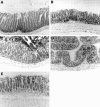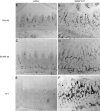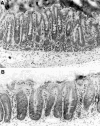Inflammatory bowel disease-like enteritis and caecitis in a senescence accelerated mouse P1/Yit strain - PubMed (original) (raw)
Inflammatory bowel disease-like enteritis and caecitis in a senescence accelerated mouse P1/Yit strain
S Matsumoto et al. Gut. 1998 Jul.
Abstract
Background: A new subline of the senescence accelerated mouse (SAM) P1/Yit strain has been established which shows spontaneous enteric inflammation under specific pathogen free (SPF) conditions.
Aims: To elucidate the pathogenesis of enteric inflammation in this new subline.
Methods: The SPF and germ free (GF) SAMP1/Yit strains were used. Histological, immunological, and microbiological characterisation of the mice with enteric inflammation was performed.
Results: Histologically, enteritic inflammation developed as a discontinuous lesion in the terminal ileum and caecum with the infiltration of many inflammatory cells after 10 weeks of age. the activity of myeloperoxidase, and both immunolocalisation and mRNA expression of inducible nitric oxide synthase increased in the lesion. CD3-epsilon positive T cells, neutrophils, and macrophages were more numerous in the inflamed mucosa of the SAMP1/Yit strain. The GF SAMP1/Yit strain did not show any inflammation in the intestinal wall, by the age of 30 weeks, and the enteritis and caecitis developed 10 weeks after the conventionalisation of the GF SAMP1/Yit strain.
Conclusion: Enteric inflammation in the ileum and caecum developed in the SAMP1/Yit strain. The pathophysiological characteristics of the disease in this mouse have some similarities to those of human inflammatory bowel disease (IBD). This mouse strain should be a useful model system for elucidating the interaction between the pathogenesis of IBD and the gut microflora.
Figures
Figure 1
Histology of the duodenum (A), ileum (B), caecum (C), proximal colon (D), and distal colon (E) in a 20 week old SAMP1/Yit mouse. Intestinal architecture was normal in the duodenum and colon (A,D,E). Morphological changes such as villous atrophy and crypt hyperplasia were pronounced in the ileum (B). In the caecum, crypt hyperplasia, characterised by crypt elongation and increased mitotic figures, could be detected (C). Toluidine blue stain. Original magnification, ×100.
Figure 2
Histological analysis of the ileum of a SAMP1/Yit mouse at 20 weeks of age. (A) Low magnification photograph of inflammatory bowel disease in the ileum of a 20 week old SAMP1/Yit mouse. The intestinal walls were thickened due to the inflammation. (B) High power view of A showing severe mucosal inflammation. Crypt hyperplasia with crypt elongation, and villous atrophy were pronounced in the lesion. Inflammatory infiltrate could be observed in the LP and submucosa. (C) Enlargement of the lymphatic vessels could be seen in the LP. (D) Higher magnification of B showing crypt undergoing necrosis (arrow) with intraluminal neutrophils. Mixed inflammatory cell infiltrate in the LP predominantly consisted of macrophages, neutrophils, and lymphocytes. (E) Crypt loss (arrow) is associated with necrotic debris in crypts. Toluidine blue stain, original magnification: A, ×40; B, ×100; C, ×200; D,E ×400.
Figure 3
_Immunohistochemical staining of the ileal mucosa. A cryostat section from IBD SAMP1/Yit and age matched control AKR/J mice was stained with monoclonal antibodies 500-A2, ER-MP-23, and Gr-1 that recognise CD3-ε, tissue macrophages, and granulocytes, respectively. CD3-_ε _positive cells, tissue macrophages, and granulocyes were more abundant in the IBD lesion in SAMP1/Yit (B,D,F) than in age matched control AKR/J mice (A,C,E). Original magnification,×_100.
Figure 4
Histological analysis of the caecum of the SAMP1/Yit strain at 20 weeks of age. (A) Mild epithelial hyperplasia resulting in crypt elongation and increased mononuclear cell infiltrate in the LP. (B) Higher magnification of the caecal epithelial lesion in the SAMP1/Yit strain at age 20 weeks. Epithelial hyperplasia with increased mitotic figures could be seen. Note that there is goblet cell depletion. Toluidine blue stain. Original magnification: A, ×_200; B,×_400.
Figure 5
Histological analysis of the skin and liver. (A) Pathology of the dorsal skin in the SPF SAMP1/Yit strain at 20 weeks of age. Loss of the epidermis can be seen in the right side of the photograph. (B) High power view of A. Inflammatory infiltrates can be seen in the dermis. (C) Higher magnification of A. A large number of neutrophils covered the epidermal ulceration. (D) Histopathology of the liver in SPF SAMP1/Yit mice at 30 weeks of age. A focal mononuclear cell infiltrate could be detected throughout the hepatic acini. Toluidine blue stain. Original magnification: A, ×40; B, ×100; C, ×200; D, ×400.
Figure 6
Ontogenic study of the inflammatory disease. Values are means (SD). *Significantly different (p<0.05) from the initial tissue weight.
Figure 7
Expression of inflammatory mediators. (A) Immunostaining of iNOS in the SAMP1/Yit strain. The expression of iNOS on the epithelial cells could be seen in both SPF SAMP1/Yit and control AKR/J mice at 20 weeks of age (arrow). However, there were more iNOS expressing cells in the LP in the 20 week old SAMP1/Yit strain than in the age matched AKR/J strain (arrowhead). Original magnification_×_100. (B) RT-PCR analysis of iNOS mRNA. The mRNA of iNOS increased in the ileum during disease development. (C) Analysis of tissue MPO activity. Tissue MPO activity in ileum was higher in the 20 week old SAMP1/Yit strain than in the age matched AKR/J strain. There were three mice per group. Similar results were obtained from two independent experiments. Values are means (SD). **Values significantly different (p<0.01) from control.
Figure 8
Effect of intestinal microflora on development of the disease. (A) In the GF SAMP1/Yit strain, the intestinal inflammatory disease that was seen under SPF conditions could not be detected, at least until 30 weeks of age. The intestinal architecture in GF littermates was quite normal, as in other strains of GF mice. (B) After contamination of 5 week old GF SAMP1/Yit mice with a faecal suspension from SPF AKR/J mice, the weight of the distal part of the small intestine was increased compared with that of age matched GF SAMP1/Yit mice (n=5) after 15 weeks. There was no difference in the intestinal tissue weight between GF SAMP1 and SPF AKR/J mice (p=0.4953). Values are means (SD). Values significantly different (*p<0.05; **p<0.01) from tissue weight of the GF SAMP1/Yit strain.
Similar articles
- The SAMP1/Yit mouse: another step closer to modeling human inflammatory bowel disease.
Strober W, Nakamura K, Kitani A. Strober W, et al. J Clin Invest. 2001 Mar;107(6):667-70. doi: 10.1172/JCI12559. J Clin Invest. 2001. PMID: 11254665 Free PMC article. Review. No abstract available. - In vivo demonstration of T lymphocyte migration and amelioration of ileitis in intestinal mucosa of SAMP1/Yit mice by the inhibition of MAdCAM-1.
Matsuzaki K, Tsuzuki Y, Matsunaga H, Inoue T, Miyazaki J, Hokari R, Okada Y, Kawaguchi A, Nagao S, Itoh K, Matsumoto S, Miura S. Matsuzaki K, et al. Clin Exp Immunol. 2005 Apr;140(1):22-31. doi: 10.1111/j.1365-2249.2005.02742.x. Clin Exp Immunol. 2005. PMID: 15762871 Free PMC article. - Pathogenesis of gastritis in ileitis-prone SAMP1/Yit mice.
Ernst PB, Wiznerowicz EB, Feldman SH, Tung KS. Ernst PB, et al. Keio J Med. 2011;60(2):65-8. doi: 10.2302/kjm.60.65. Keio J Med. 2011. PMID: 21720202 Review. - Blockade of PSGL-1 attenuates CD14+ monocytic cell recruitment in intestinal mucosa and ameliorates ileitis in SAMP1/Yit mice.
Inoue T, Tsuzuki Y, Matsuzaki K, Matsunaga H, Miyazaki J, Hokari R, Okada Y, Kawaguchi A, Nagao S, Itoh K, Matsumoto S, Miura S. Inoue T, et al. J Leukoc Biol. 2005 Mar;77(3):287-95. doi: 10.1189/jlb.0204104. Epub 2004 Nov 29. J Leukoc Biol. 2005. PMID: 15569697
Cited by
- The SAMP1/Yit mouse: another step closer to modeling human inflammatory bowel disease.
Strober W, Nakamura K, Kitani A. Strober W, et al. J Clin Invest. 2001 Mar;107(6):667-70. doi: 10.1172/JCI12559. J Clin Invest. 2001. PMID: 11254665 Free PMC article. Review. No abstract available. - Hematopoietic not systemic impairment of Roquin expression accounts for intestinal inflammation in Roquin-deficient mice.
Montufar-Solis D, Vigneswaran N, Nakra N, Schaefer JS, Klein JR. Montufar-Solis D, et al. Sci Rep. 2014 May 12;4:4920. doi: 10.1038/srep04920. Sci Rep. 2014. PMID: 24815331 Free PMC article. - Experimental Models of Inflammatory Bowel Diseases.
Kiesler P, Fuss IJ, Strober W. Kiesler P, et al. Cell Mol Gastroenterol Hepatol. 2015 Mar 1;1(2):154-170. doi: 10.1016/j.jcmgh.2015.01.006. Cell Mol Gastroenterol Hepatol. 2015. PMID: 26000334 Free PMC article. - In vivo demonstration of T lymphocyte migration and amelioration of ileitis in intestinal mucosa of SAMP1/Yit mice by the inhibition of MAdCAM-1.
Matsuzaki K, Tsuzuki Y, Matsunaga H, Inoue T, Miyazaki J, Hokari R, Okada Y, Kawaguchi A, Nagao S, Itoh K, Matsumoto S, Miura S. Matsuzaki K, et al. Clin Exp Immunol. 2005 Apr;140(1):22-31. doi: 10.1111/j.1365-2249.2005.02742.x. Clin Exp Immunol. 2005. PMID: 15762871 Free PMC article. - The scent of age.
Osada K, Yamazaki K, Curran M, Bard J, Smith BP, Beauchamp GK. Osada K, et al. Proc Biol Sci. 2003 May 7;270(1518):929-33. doi: 10.1098/rspb.2002.2308. Proc Biol Sci. 2003. PMID: 12803907 Free PMC article.
References
- Mech Ageing Dev. 1981 Oct;17(2):183-94 - PubMed
- Infect Immun. 1997 Aug;65(8):3126-31 - PubMed
- Gastroenterology. 1984 Dec;87(6):1344-50 - PubMed
- Am J Pathol. 1986 Nov;125(2):276-83 - PubMed
- Immunology. 1987 Nov;62(3):419-23 - PubMed
MeSH terms
Substances
LinkOut - more resources
Full Text Sources
Other Literature Sources
Molecular Biology Databases
Research Materials







